This Day in Rock History - July 2nd

1979: It was on this day that Sony introduced the world’s first portable cassette player, the Walkman.
This Day in Rock History - July 1st
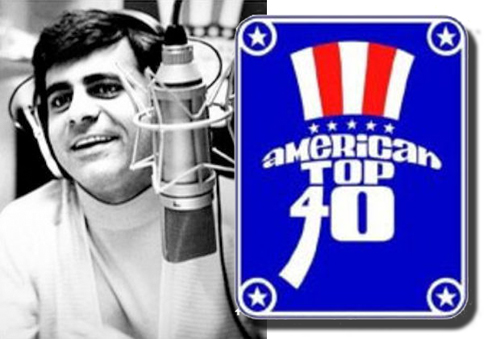
1970: Casey Kasem begins a weekly syndicated radio show called “American Top 40.” And now, back to the countdown…
Reducing Gum Disease, By Gum
 We pretty sure you’ve probably never heard of “oil pulling.”
We pretty sure you’ve probably never heard of “oil pulling.”
It’s a practice that comes from ancient India that involves swirling coconut or sesame oil in your mouth for 20 minutes a day. Studies show that the oil “pulls” bacteria from the mouth.
There are those who also claim it whitens teeth, but there is no current research to back up that claim.
This Day in Rock History - June 30th
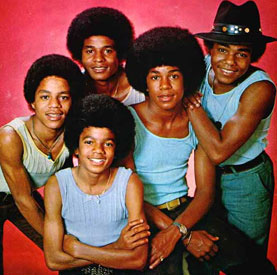

1975: The Jackson 5 announce they are leaving Motown Records to sign with the Epic label. It turns out, Motown owned the name “The Jackson 5,” so the lads promptly rename themselves just “The Jacksons.”
This Day in Rock History - June 29th
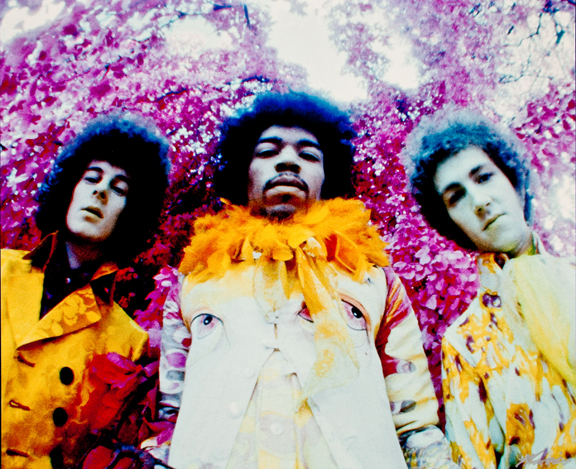
1969: The Jimi Hendrix Experience plays their last gig, appearing for the final time at the Denver Pop Festival.
This Day in Rock History - June 28th

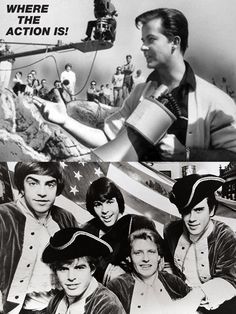 1965: ABC-TV debuts the newest pop music show from producer Dick Clark. Where the Action Is features a theme song by Freddy Cannon, appearances by Jan & Dean, Linda Scott and Dee Dee Sharp as well as introducing America to the show’s “house band,” a little combo from Portland by the name of Paul Revere and the Raiders.
1965: ABC-TV debuts the newest pop music show from producer Dick Clark. Where the Action Is features a theme song by Freddy Cannon, appearances by Jan & Dean, Linda Scott and Dee Dee Sharp as well as introducing America to the show’s “house band,” a little combo from Portland by the name of Paul Revere and the Raiders.
Slow Dancer (1974)
A Hidden Treasure From Rock & Soul’s Golden Era
A series of posts about albums you may have missed back in the day when so much good music was coming out on nearly a daily basis. But now that the real “good stuff” is few and far between, you might want to backtrack and add these gems to your music collection.
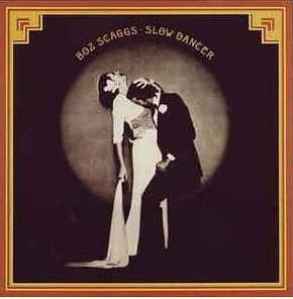 It happens so often in rock music. Artists struggle for years with albums the critics love but record buyers ignore. Then they finally break through to a wider audience and go on to long, successful careers. Yet, those earlier albums remain, for the most part, ignored.
It happens so often in rock music. Artists struggle for years with albums the critics love but record buyers ignore. Then they finally break through to a wider audience and go on to long, successful careers. Yet, those earlier albums remain, for the most part, ignored.
Such is the case with Boz Scagg’s “Slow Dancer” in 1974. It was his 6th album and his 6th commercial failure. Yet, many die hard Boz fans will tell you “Slow Dancer” is his best album. We don’t think they’re wrong.
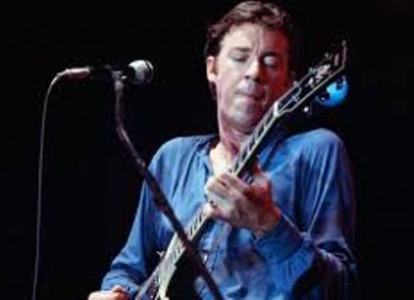
William Royce Scaggs was given the nickname “Bosley” while still in grade school. It was quickly shortened to “Boz” and obviously stuck. Boz was an original member of the Steve Miller Band (having been friends with Miller since the age of 12).
Whether you call it “white” or “blue-eyed” soul, Boz as a solo artist has always been one of the best of the white boys to sing rhythm and blues.
For “Slow Dancer,” Scaggs teamed with veteran Motown songwriter and producer Johnny Bristol. Bristol had produced “Ain’t No Mountain High Enough” for Marvin Gaye & Tammi Terrell, “Twenty Five Miles” for Edwin Starr, “What Does It Take (To Win Your Love)” for Junior Walker and “Someday Will Be Together” for Diana Ross and the Supremes (that’s Bristol himself singing the male vocal to Ross’ lead).
(In fact, 1974 was a very good year for Bristol. He also scored his one and only hit as a singer with “Hang on in There Baby,” which hit the Top 10 in both the US and the UK.)
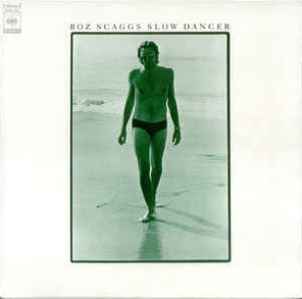 Together or separately, Bristol and Scaggs composed 9 of “Slow Dancer’s” 10 tracks. They include:
Together or separately, Bristol and Scaggs composed 9 of “Slow Dancer’s” 10 tracks. They include:
“You Make It So Hard (To Say No)”
“Slow Dancer”
“Angel Lady (Came Just in Time)”
“There Is Someone Else”
“Pain of Love”
“Sail on White Moon”
“Let It Happen”
“I Got Your Number”
“Take It for Granted”
The one song on the LP that neither man had a hand in writing was “Hercules” (no relation to the Elton John tune) penned by veteran songsmith Allen Toussaint.
The entire album features lush orchestrations with full string and horn sections. At some points, it almost sounds Boz is making his bid to become our generation’s Sinatra. Regardless, there is not one wasted track on the entire album. Each one is a polished gem of soul and sensuous sophistication.
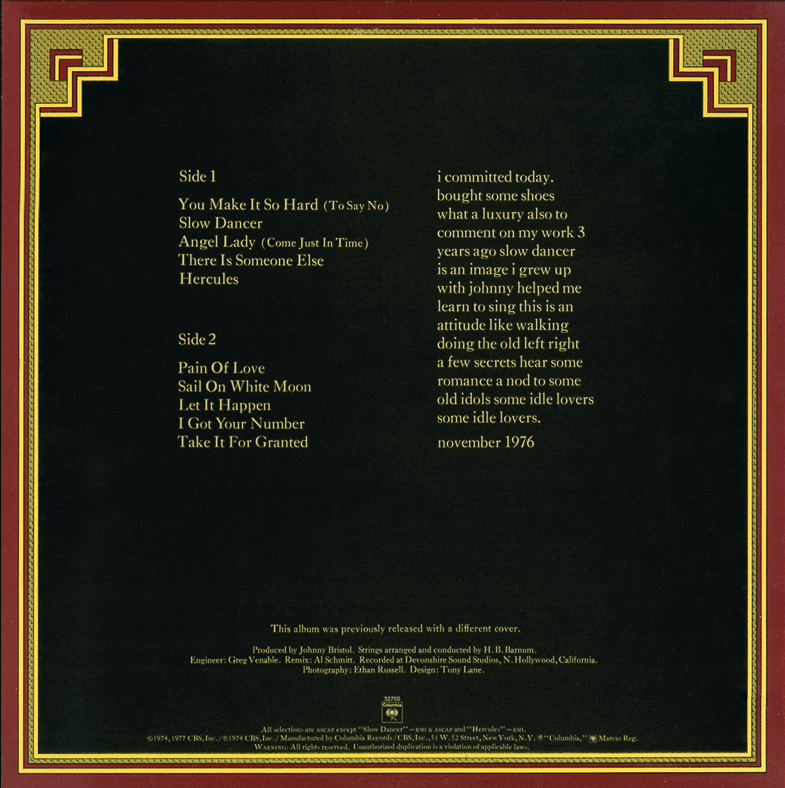 “Slow Dancer” was Boz Scaggs’ best-selling album to that point, but that’s not saying much. It peaked at #81 on Billboard’s Hot 100 Albums and then sank like a stone.
“Slow Dancer” was Boz Scaggs’ best-selling album to that point, but that’s not saying much. It peaked at #81 on Billboard’s Hot 100 Albums and then sank like a stone.
That Boz was slightly ahead of his time should be obvious. His next album, released 1976, was “Silk Degrees.” That record hit the top of the charts worldwide, spun off multiple hit singles and went 5X Platinum.
Over time, many have finally discovered to sonic smoothness of “Slow Dancer.” The album has been certified Gold. But still, too few people really know this rare pop gem.
Do yourself a favor. Track down a copy. Then settle back in your favorite easy chair with your favorite adult beverage close at hand, close your eyes and let Boz show you just how good a white boy can sing those rhythm and blues.
The Movie That Changed Everything: "A Hard Day's Night"
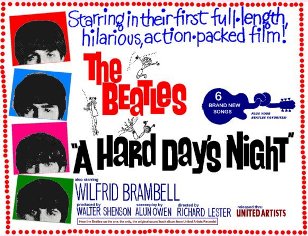
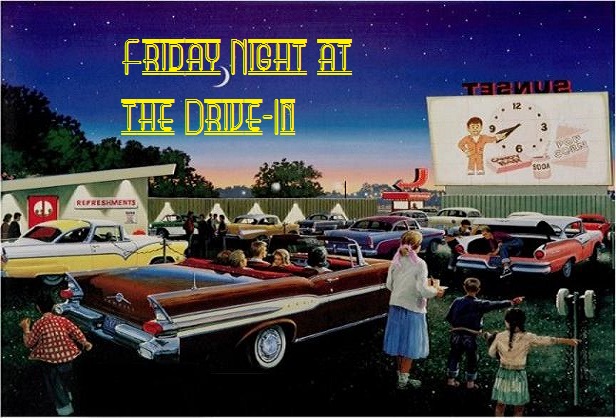 Now, more than half a century later, there has never been a rock & roll film that has surpassed “A Hard Day’s Night.” Not only is it a great rock movie and a superb time capsule showing how insane Beatlemania was at its height, but it is simply a great movie (having made many “100 Greatest Films” lists) that influenced many subsequent filmmakers and is credited with single-handedly inventing the music video.
Now, more than half a century later, there has never been a rock & roll film that has surpassed “A Hard Day’s Night.” Not only is it a great rock movie and a superb time capsule showing how insane Beatlemania was at its height, but it is simply a great movie (having made many “100 Greatest Films” lists) that influenced many subsequent filmmakers and is credited with single-handedly inventing the music video.
The next time you watch this classic, here are some things you can watch for that you might have missed before.
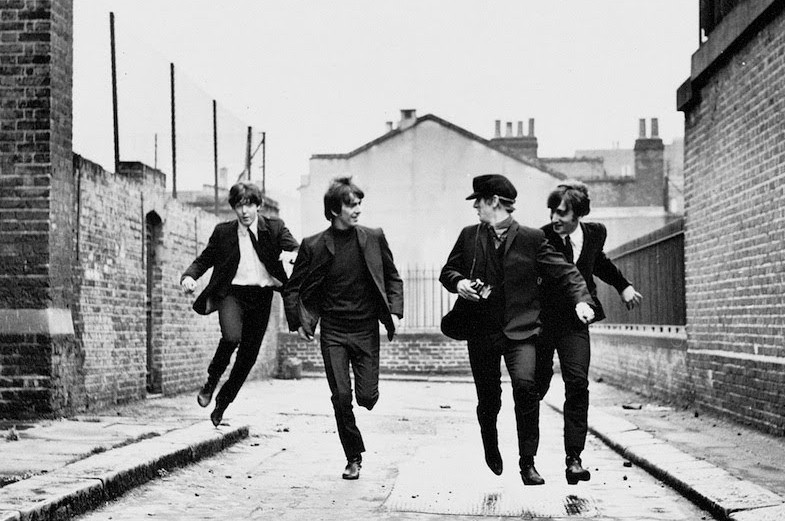
- The film’s shooting title was “Beatlemania.” Who made the actual decision to change it to “A Hard Day’s Night” is in dispute, but all agree the phrase was originally created by Ringo after a grueling work session.
- United Artists was sure that Beatlemania was just a passing fad. They authorized a very small budget ($500,000), and memos at the time show that the studio thought the film would lose money. They were really only interested in the soundtrack album (where they believed they would make up the money they lost on the film). That’s the main reason the film was shot in black and white.
- Those opening scenes, where the boys are being chased by rabid fans to and through Marylebone Rail Station in London? The boys really are running for their lives. The film company used genuine Beatles fans who actually were trying to get their hands on the Fab Four.
- Look closely and you’ll see that George falls during that chase and Ringo goes tumbling after him. There was no way to cut due to those screaming fans. So the lads have to pick themselves up and continue their mad dash.
- While the script seems at times to be ad-libbed, it was all scripted. Screenwriter Allun Owen spent several weeks with the Beatles, and all concerned say he came away with an incredible knack for being able to mimic their cheeky style.
- One of the young schoolgirls on the train was Patti Boyd, who went on to become George Harrison’s first wife and later, Eric Clapton’s wife. She was also to inspire the songs “Something (In the Way She Moves)” and “Layla.”
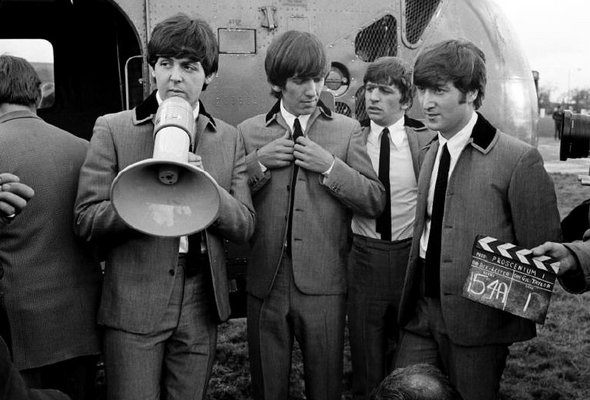 In the famous “Can’t Buy Me Love” scene (credited with being the very first rock video), John was not available for the filming, and so a double was used for the aerial shots.
In the famous “Can’t Buy Me Love” scene (credited with being the very first rock video), John was not available for the filming, and so a double was used for the aerial shots.- There is an “in” joke in the constant references to Paul’s grandfather as a “clean old man.” At that time, the actor playing John McCartney (Wilfred Bramell) played a junk man on British TV’s Steptoe and Son (the later American version was named Sanford and Son). As Steptoe, Bramell was constantly called a “dirty old man.” So the “clean old man” gags were funny to British audiences, but went right over the heads of American audiences.
- During the rapid-fire press conference/cocktail party, asked what he calls his hairstyle, George replies, “Arthur.” That name was picked up and used as the name of an early, trendy New York discotheque (pre-Studio 54).
- Don’t know if you’ll recognize him, but a very young Phil Collins is in the audience of kids at the televised concert that comes near the end of the film.
- Studio execs at United Artists in the States thought the Beatles’ accents would be incomprehensible to American audiences and asked that their real voices be replaced by voice actors with more “proper” British accents. Director Richard Lester declined their request.
- Where’s Paul’s solo scene? The other three Beatles all get short solo scenes: George with a TV producer, John with a dancer, and, of course, Ringo going “adventuring.” But why no solo scene for Paul?
- Actually, there was. It was an encounter between Paul and an actress that happens while Paul is out looking for Ringo. The scene was shot but cut from the film because director Richard Lester felt it simply didn’t work. It came off as too stagey. Alas, the footage for this unused scene was destroyed by the studio in the days long before home video and bonus features were ever dreamed of. However, the scene did make it into the paperback novelization of the film, and the actual script for it can be found here.
- The group’s name, “the Beatles,” is never said, even once, during the film. (It does appear on Ringo’s drum kit, the stage lighting during the concert, and a helicopter at the end, but no one ever mentions their name out loud.)
Do yourself a favor and rent, buy, or stream a copy of this classic soon.
This Day in Rock History - June 27th
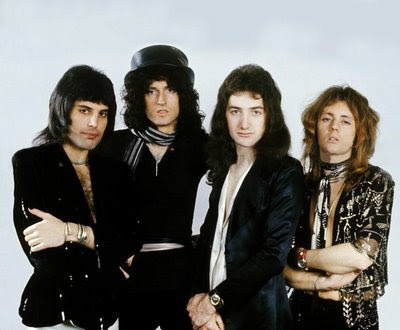
1970: The British band, Smile, performs at Truro City Hall in Cornwall, England, for the first time under their new name – Queen.
This Day in Rock History - June 26th
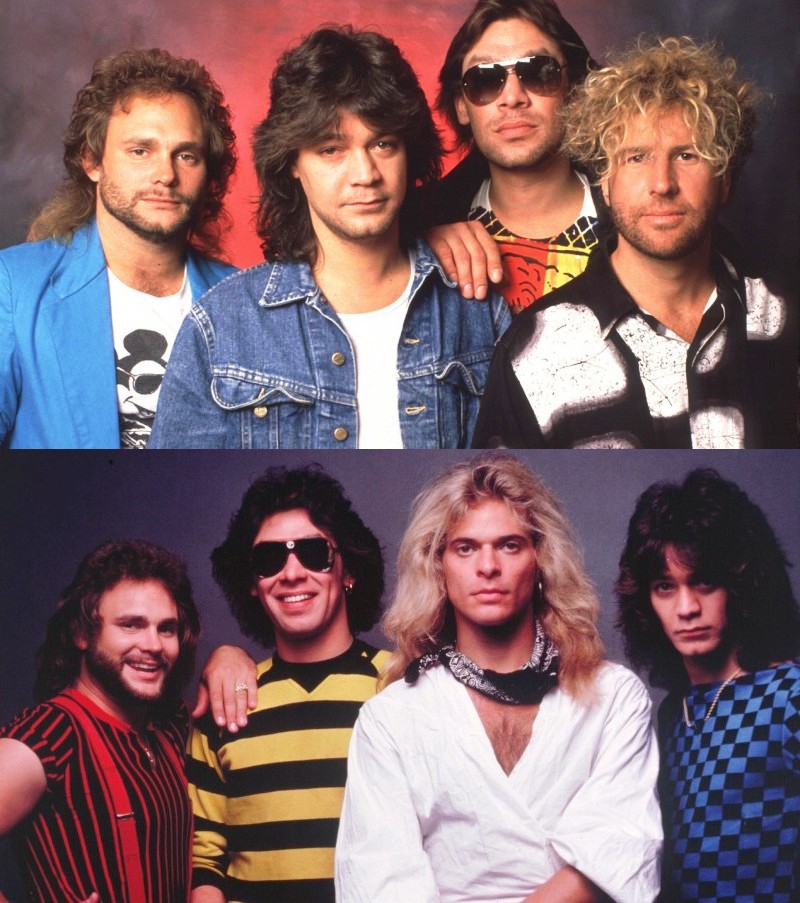
1996: Van Halen announces they are dumping their vocalist Sammy Hagar and reinstating their original vocalist David Lee Roth. The Van Hagar-Van Halen debate continues to this day.
Pop Up Player
Latest Posts–Movies & TV
-
The TV That Time Forgot: Annie Oakley
There was a time when Westerns dominated television programming so thoroughly that it was tough (with no home video, no streaming, and just 3 networks if you lived in a city big enough to have…
-
The TV That Time Forgot: My Living Doll (1964-65)
For a show that lasted only a single season, a surprising number of Baby Boomers remember the situation comedy My Living Doll. Perhaps that’s because once seen, Julie Newmar cannot easily be forgotten. The situation…
-
Alfred Hitchcock Presents
While often lumped together with “The Twilight Zone” and “Boris Karloff’s Thriller,” “Alfred Hitchcock Presents” is the true original, debuting 4 years before TZ and 5 before “Thriller.” Alfred Hitchcock’s show was also different than…
-
The TV That Time Forgot: The Donna Reed Show
For 8 seasons, The Donna Reed Show provided Baby Boomers with a sort of Mother Knows Best amid a ton of family sitcoms focused on the father. Cast as Donna Stone, Donna presided over a…
-
Friday Night at the Drive-In: Lover Come Back (1961)
Sequels & remakes? Nothing new here – Hollywood’s been recycling stuff ever since the first “magic lantern shows.” Want proof? Let’s settle in to watch one of those terribly puritanical “sex comedies” from the Sixties…
-
The TV That Time Forgot: The Millionaire
Boy! Could we use a show like this in real life! From 1955 to 1960, for 5 seasons an eccentric millionaire would give away $1 million to somebody he never even met. We were allowed…


